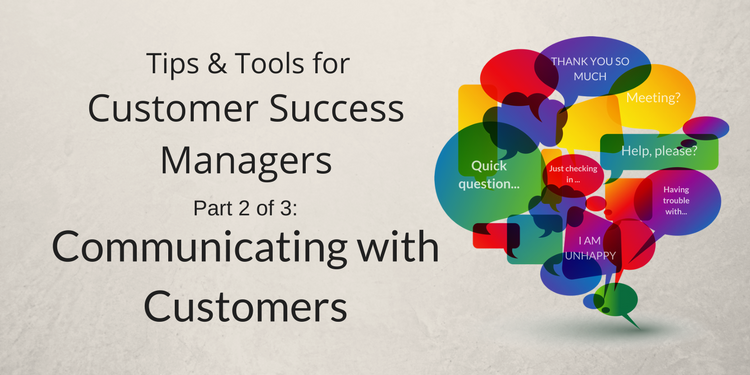Communication Tips & Tools for Customer Success Managers

In Customer Success, communication with accounts can make or break the job. Upping your skills—and having the right tools to make the back and forth efficient—can help you win customers for life.
Wootric has gathered some tips and tools to help you communicate with your customers at scale.
In the first part of this three-part series, we gave you tips and tools to help with time management. Use the time you saved to improve your customer relationships and communication processes.
Communicating with Customers
Tips:
-
Nail down specific measurable criteria/objectives in onboarding
When you start building a relationship with the client, the most important part of ensuring client success is establishing what success means to them. Oftentimes, clients come to you with large, lofty, general goals like “improve customer experience”. Create SMART goals with your customers during onboarding and establish a baseline so that you can prove to them, objectively, that your company is delivering value.
“You can focus on adoption, retention, expansion, or advocacy; or you can focus on the customers’ Desired Outcome and get all of those things.” Lincoln Murphy, co-author of Customer Success: How Innovative Companies Are Reducing Churn and Growing Recurring Revenue
-
Master telling a client “no” with grace
Nobody likes to hear “no”, not toddlers, not teenagers, and especially not adults. When you are dealing with customers, you will inevitably run into requests that you cannot and should not fulfill. It’s an unpleasant part of the job.
You can deal with this situation in a multitude of ways, and prior experience with your customer can guide you to the best method. It might be suggesting the closest alternative, or it might be providing a detailed explanation. Regardless of how you choose to tell them no, it is key to maintain your relationship with them, and maintain your position on their team, as their advocate, the whole time.
-
Listen for the “silently churning”
All too often CSMs default to listening to the clients who shout the loudest. This is a natural human response, but leaves you vulnerable to neglecting your clients who are less vocal. Just because someone isn’t complaining to you in an email or over the phone, doesn’t mean they’ll renew when the contract is up.
Maintain a pulse on your client portfolio with the help of metrics like NPS, CES, and CSAT. Surveying customers after interactions and a couple times a year will provide invaluable insight into the health of your accounts. Survey feedback and analysis helps focus on the “silently churning”, the customers who are simply disengaging instead of yelling, and helps to narrow down what actually drives their lack of enthusiasm.
Tools:
Boomerang:
Boomerang is a free email extension that lets you schedule emails to be sent, remind yourself if you don’t hear back, and take messages out of your inbox until you actually need them. Boomerang will archive your message, then bring it back to your inbox at a time you choose, marked unread, starred or at the top of your message list. You can use Boomerang as an automation tool for following up or checking in with clients, especially when you don’t hear back from them.
Text expansion apps like Text Expander:
Text expansion applications use a few basic mechanisms to make typing faster. Abbreviate blocks of text that you use often and the app will replace it with the full block of text that you assign to the abbreviation. For example, you could have the app insert “Customer Success Manager” everytime you type “csm”.
Grammarly:
Grammarly uses AI to detect grammar, spelling, punctuation, word choice, and style mistakes in your writing, offering you alternatives in real-time. Grammarly has recently been detecting micro-aggression and intent in emails, offering alternatives to help maintain professional relationships. It can also offer vocabulary enhancement suggestions for people using English as a second or third language.
Note: if you regularly use the Google suite of software, like Documents or Slides, you’ll have to stick with their autocorrect algorithms or take the extra step to upload documents into Grammarly’s own dashboard for corrections.
Doodle:
Doodle is a straightforward scheduler that helps you coordinate a time for meetings. You suggest a few dates and times for your participants. Doodle then creates a polling calendar that can be sent to them for feedback. As each person selects the dates and times they are free, Doodle aggregates the responses to tell you which option works best for everyone.
Calendly:
Calendly is also a scheduler that helps you schedule meetings without the back-and-forth emails. It has many more integrations and features than Doodle, which means it takes more getting used to, but is much more robust. Calendly takes time zones into account for each invitee and even allows you to request payments via Paypal and Stripe.
Retain more customers. Sign up today for free Net Promoter Score feedback with InMoment.





